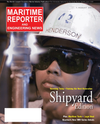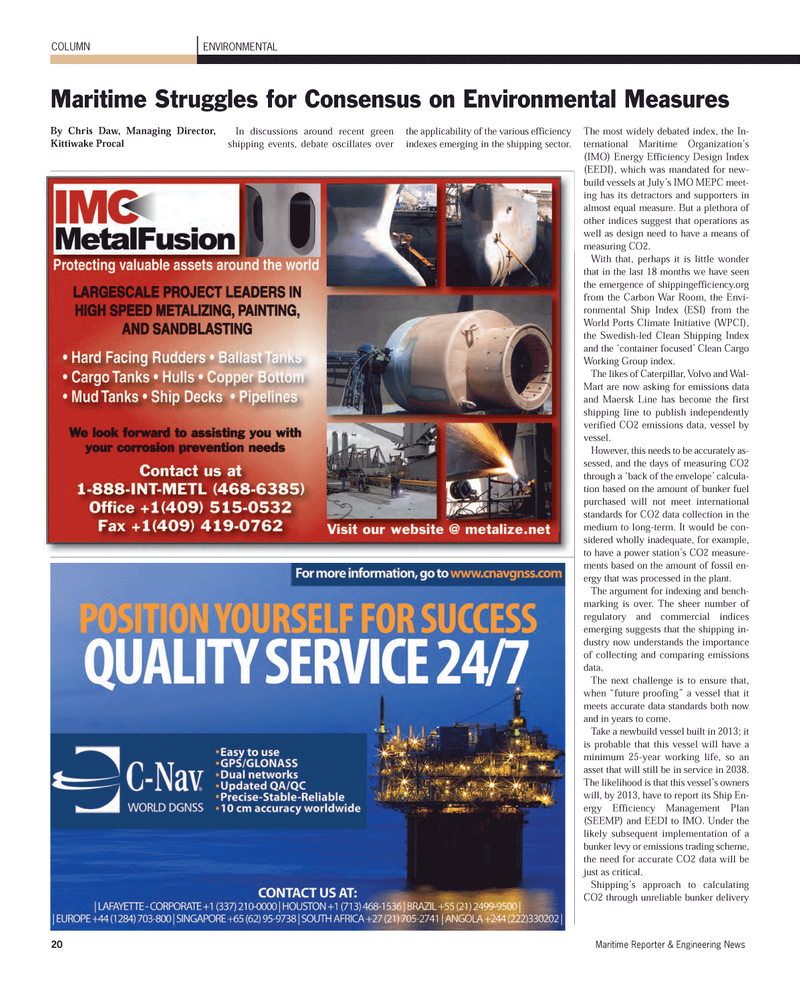
Page 20: of Maritime Reporter Magazine (August 2011)
Top 20 Shipyards of the World
Read this page in Pdf, Flash or Html5 edition of August 2011 Maritime Reporter Magazine
Maritime Struggles for Consensus on Environmental Measures By Chris Daw, Managing Director, Kittiwake Procal In discussions around recent greenshipping events, debate oscillates over the applicability of the various efficiency indexes emerging in the shipping sector. The most widely debated index, the In- ternational Maritime Organization?s (IMO) Energy Efficiency Design Index (EEDI), which was mandated for new- build vessels at July?s IMO MEPC meet- ing has its detractors and supporters inalmost equal measure. But a plethora ofother indices suggest that operations aswell as design need to have a means of measuring CO2.With that, perhaps it is little wonder that in the last 18 months we have seen the emergence of shippingefficiency.org from the Carbon War Room, the Envi- ronmental Ship Index (ESI) from the World Ports Climate Initiative (WPCI), the Swedish-led Clean Shipping Index and the ?container focused? Clean Cargo Working Group index. The likes of Caterpillar, Volvo and Wal- Mart are now asking for emissions data and Maersk Line has become the first shipping line to publish independentlyverified CO2 emissions data, vessel by vessel. However, this needs to be accurately as- sessed, and the days of measuring CO2through a ?back of the envelope? calcula- tion based on the amount of bunker fuel purchased will not meet internationalstandards for CO2 data collection in themedium to long-term. It would be con- sidered wholly inadequate, for example, to have a power station?s CO2 measure- ments based on the amount of fossil en-ergy that was processed in the plant. The argument for indexing and bench- marking is over. The sheer number of regulatory and commercial indices emerging suggests that the shipping in- dustry now understands the importance of collecting and comparing emissionsdata. The next challenge is to ensure that, when ?future proofing? a vessel that it meets accurate data standards both now and in years to come. Take a newbuild vessel built in 2013; it is probable that this vessel will have a minimum 25-year working life, so an asset that will still be in service in 2038.The likelihood is that this vessel?s owners will, by 2013, have to report its Ship En- ergy Efficiency Management Plan (SEEMP) and EEDI to IMO. Under thelikely subsequent implementation of a bunker levy or emissions trading scheme, the need for accurate CO2 data will bejust as critical. Shipping?s approach to calculating CO2 through unreliable bunker delivery ENVIRONMENTAL COLUMN20Maritime Reporter & Engineering News MR Aug. 11 # 3 (18-24):MR Template 8/3/2011 10:22 AM Page 20

 19
19

 21
21
